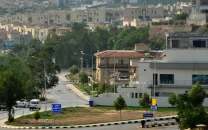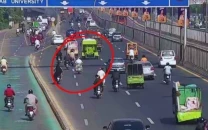Eid cattle sales now a middlemen's game
Livestock traders see a record 30-34% drop in sale of sacrificial animals in Pindi

The sale of sacrificial animals has now become a fully commercial and highly profitable business, with the profits increasingly going to middlemen. Both the original owners of the animals — typically farmers and herders — and the end buyers incur losses. As a result, the demand for sacrificial animals continues to decline.
According to contractors and livestock traders in Rawalpindi, this year saw a record 30% to 34% drop in the sale of sacrificial animals in the city. If a proper mechanism for the sale and purchase of sacrificial animals is not developed within the next two years, this decline could exceed 50%.
A survey shows that immediately after Eidul Fitr, middlemen begin purchasing animals directly from villages through local agents. They pay in advance and transport the animals to their own farms, where they keep them for two months, set their own prices, and earn significant profits. When the moon of Eidul Azha is sighted, these animals are brought to the livestock markets.
These middlemen buy animals at cheap rates directly from farmers and livestock owners, who barely make any profit. Meanwhile, consumers are forced to purchase the same animals at much higher prices.
In addition, livestock markets have been fully commercialised. The market contractors, who often have no direct involvement with animals, win multimillion-rupee tenders from the municipal or district administration. They then rent out space in the market to livestock traders at rates ranging from Rs500,000 to Rs1 million per kanal for just 10 days.
Other costs, such as electricity, water tankers, animal feed, tents for shade, and fans for ventilation, all add to the overall expense. An amount of Rs7,000 entry fee is also charged for a large animal and Rs4,000 for a smaller one. Loading and unloading charges are additional, and all of these expenses ultimately fall on the buyer.
Previously, the original animal owners would sell their livestock directly in streets and local markets, with no market fees or middlemen involved. Now, however, what was once a religious tradition has been turned into a profit-driven industry by a growing mafia.
Raja Khan, a contractor on High Court Road, explained that he rented one kanal of land for Rs800,000 for 10 days. Daily, he spent Rs3,500 on a water tanker, Rs10,000-15,000 on animal feed, and Rs2,000 on food for his three workers, who also bathed the animals to keep them cool in the summer heat.
His electricity bill alone for 10 days was Rs100,000. Khan added even government and police officials didn't pay full price for animals. "Under such conditions, how can we sell animals at cheaper rates?" he said. "Every year, animal prices increase by Rs40,000 to Rs80,000. Within the next three to five years, sales may drop by 70%, and prices could rise by 50% to 70%."
Contractor Irshad Abbasi says if market tender fees are abolished, animal prices could drop by 30% to 40% in a single day. He held the middlemen and administration responsible for the rising prices, adding: "When livestock markets are auctioned for Rs150 million to Rs180m, how can animals be sold cheaply?"
This year, even on the eve of Eid, sales remained sluggish. By 9pm on Chand Raat, the market had essentially collapsed. Prices were reduced by up to 30%, but most genuine buyers had already left. As a result, many animals went unsold. Some were purchased by butchers at the last moment. Those who came after 9pm were able to buy good animals at 30% to 40% lower prices.
Another major reason for the decline in sacrificial activity is the Rs 20,000 slaughtering fee for cows and bulls.




















COMMENTS
Comments are moderated and generally will be posted if they are on-topic and not abusive.
For more information, please see our Comments FAQ